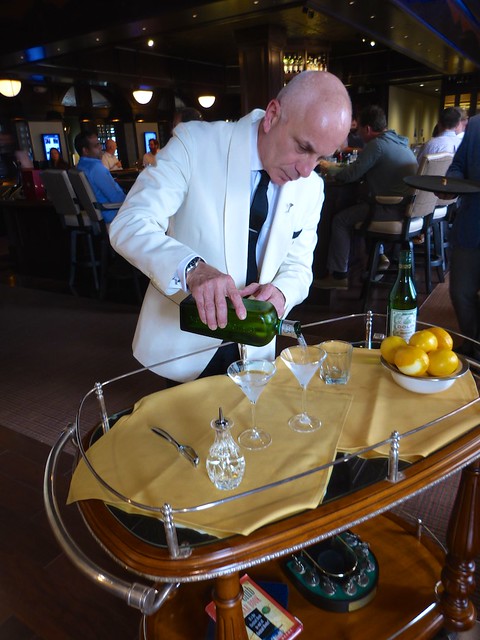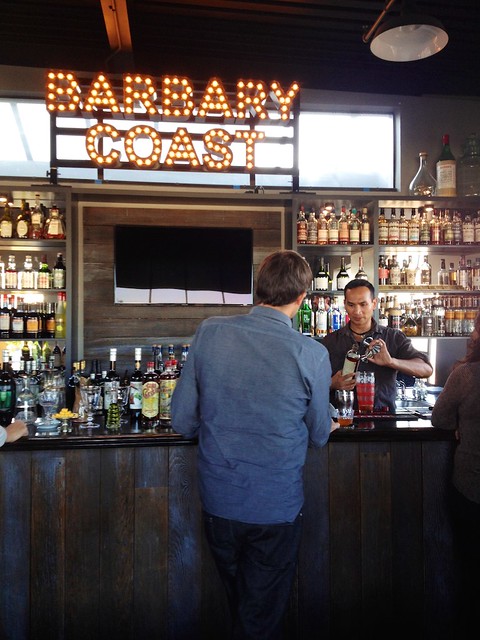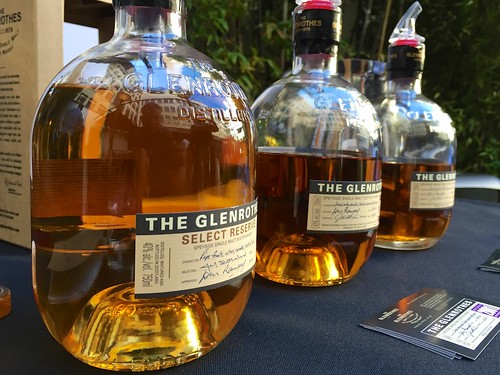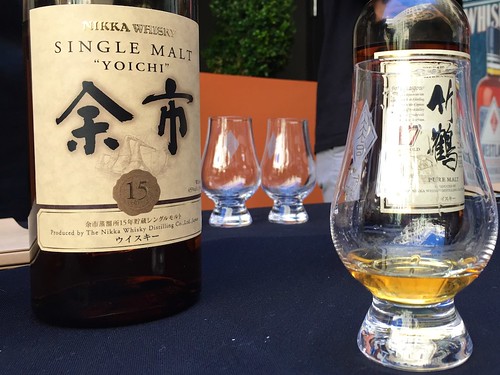Booze, Sweetie
Apparently, the good folks over at Anchor Distilling (by way of Wagstaff Worldwide) know I like booze. Good booze, specifically. And lately they've been gracious enough to invite me to a few events to sample some of their wares.
Back in August we went to Wingtip, the très swank private club in the Financial District, to meet a cocktailian legend, Alessandro Palazzi of the DUKES Hotel in London. The DUKES garnered a fair bit of fame by being the regular haunt of none other than Sir Ian Fleming himself, and it is believed that it is where he acquired the inspiration for James Bond's propensity for martinis "shaken, not stirred." (Though, in fact, Bond is at least as famous for creating a cocktail all his own, the Vesper.) Palazzi was here to showcase his take on the classic, dubbed the DUKES Classic Dry Martini.
Palazzi, a slight man in a dapper white shawl-collar tux, wheeled up a wooden cart adorned with just a bowl of Meyer lemons, a crystal bottle with a shaker top, containing his house vermouth, and a bottle of No. 3 Gin (represented by Anchor Distilling). No. 3 is a London Dry Gin which starts out as a neutral spirit infused with botanicals including the classic juniper, angelica and sweet orange peel, but somewhat uniquely also grapefruit peel, lending a fresher citric edge. Speaking softly with a pronounced Italian accent, Palazzi explained that he uses No. 3 in combination with citrus, specifically Amalfi lemons from Italy back in London, as opposed to the classic olives to enhance the natural citrus aromas in the gin. (The recipe is on the No. 3 Gin site.) Out of respect for local ingredients, and because you cannot bring lemons into the state of California, he used meyers on this day.
Two bracingly chilled cocktail glasses were delivered from the bar. At the DUKES, cocktail glasses are chilled in the freezer at least 24 hours; this chills the cocktail right in the glass, eliminating the need for stirring or shaking, and thereby not diluting the cocktail. A scant few dashes of house vermouth went into the glass, swirled around the interior, and in went the gin. He cut a slice of lemon rind, twisted it over the top to release the oils, and dropped it in. Like so:
I am certain that Bond would approve.
Anchor Distilling has also recently begun to represent Tempus Fugit Spirits, makers of classic amari, liqueurs, absinthes, cremes and, now, vermouths. They hosted an event in their private bar on the rooftop of the Anchor Brewing building in Potrero Hill. (My friend Emily was there, too.)
Founder John Troia was on hand to talk about the product line, of course, but much more than that. Troia is a treasure trove of information on vintage European spirits, many of which Tempus Fugit is bringing back from the virtual grave. One of them, Gran Classico, has been a mainstay in our house for years. Modeled after a defunct recipe for Torino Gran Classico, a classic amaro from Turin, it comes off initially with a similar bitter-sweet balance as others like Campari, but far more complex. I was not as familiar with the rest of their offerings, but I certainly am now.
As Troia spouted an endless and endlessly entertaining stream of trivia around the culture surrounding these spirits in the 19th century, we had a chance to sample the various spirits, starting with the Kina Aéro d'Or. The name Kina comes from quinquina, or chincona, the bark that contains quinine, the same stuff that gives tonic water its tangy-bitter edge. Like tonic water, Kina has its roots in medicinal use, to stave off malaria. Similar to Gran Classico, Kina has a viscous texture and a similar bittersweet note, with a bit more sourness.
From there it was on to their new vermouths. The bottles at the tasting had been flown in specially, making us among the first to taste them in the US. One, the Vermouth Chinotto, again relies on chincona for quinine's bitterness, but was very balanced. It's comparable to Carpano Antica, which has an even more assertive quinine note. I found it very refreshing. The other, Vermouth di Torino, leveraged orange rind for its signature note.
Troia went on to note that, as with everything we'd be tasting, vermouths were not only meant to be drank on their own, but were considered quite posh. Wine was expensive enough, and the botanicals used were even more precious. While these vermouths would be excellent in cocktails, they're very recommendable straight up chilled or on the rocks. (Carpano Antica with sparkling water on ice is a favorite in our house, soon to be replaced by the Chinotto.)
The crèmes were a revelation. Crèmes are effectively hyper-sweetened liqueurs, whose high sugar content gives them a creamy mouthfeel. Tempus Fugit has restored dignity to the two major varieties, crème de cacao and crème de menthe. Again, in their original incarnation, these were enjoyed at the end of a meal as a digestif, and in the case of crème de menthe, a postprandial breath freshener. For the crème de cacao, they again went back to original recipes, and ultimately even returned to the Venezuelan source for the cacao called for in the original recipe they were using. This had the rounded, lingering flavor of excellent-quality dark chocolate, not unlike tasting one of Dandelion's hand-crafted bars. An ounce of this would make a very fine dessert indeed. For the crème de menthe, they used not only spearmint and peppermint, but coriander and other herbs to round it out and give it more complexity and structure. The result was a liqueur that filled the palate with cooling mint, and no harshness. By contrast, he poured me a small shot of a mainstream brand crème de menthe (I won't name which, but you probably have it on your shelf), and after the Tempus Fugit it tasted like mentholated gasoline.
Tempus Fugit actually got their start in absinthe, rebooting an esteemed brand, Vieux Pontarlier. They've gone on to launch other brands; I tasted the Vieux Pontarlier and the Duplais. (They also make Mansinthe, a custom label for Marilyn Manson. Take that as you will.) While I am no connoisseur of absinthes, and could not really tease out too much subtlety between them (especially after tasting everything else), it was fascinating listening to Troia talk about absinthe culture in France in the late 19th century. It was not the Belle Epoque for everyone, and so absinthe became a popular alternative to expensive wine. If you were a lower-class worker living in an attic apartment with no heat or insulation, you might find yourself in a local brasserie, taking a moment to warm yourself over a simple meal and coddling a glass of absinthe. Since it got watered down about 4:1, you could nurse that one glass for a fraction the cost of a bottle of wine, and forget your troubles for at least a couple hours.
If ever you've been told to light a sugarcube on fire before drizzling absinthe over, forget it. Sugarcubes were in fact used to sweeten somewhat inferior versions of the spirit, but consuming burnt sugar is a profoundly unpleasant experience. Early on, people would etch the neck of a stirring spoon in a hatchmark pattern, and splay it out to form a sort of sieve, which would lay over the top of the glass and hold the sugarcube. Over time, as absinthe culture became more popular, specialized spoons with grillwork in the necks began to be made, and ultimately the absinthe spoon became a specially designed utensil all its own. But a good quality absinthe doesn't require sugar; it has a natural sweetness from the anise and fennel compounds which make up the primary flavor of the liquor.
Glasses became specialized as well, with fill lines indicated in the shape of the glass for the liquor, so that there was room to dilute with water. If ever you've done this, with absinthe or its wormood-free cousin Pernod, you know the peridot-green liquor turns opaque greenish white in a process called louche. This results from the volatile oils that are responsible for the liquorice-like flavors coming out of solution; the aroma is kicked up at the same time. If ever you wonder how much water to add, the liquor tells you itself. Simply add until it's gone completely opaque.
Finally, as part of WhiskeyFest 2014, I popped by Dirty Habit on a sweltering October afternoon to sample some of the whisky brands Anchor represents. While Anchor of course has their own spirits, like Old Potrero whiskeys, Junipero and Genevieve gins and Hophead vodka, they represent a portfolio of whiskeys from around the world. Their flagship scotch is The Glenrothes, in Speyside.
Glenrothes operates slightly differently than most scotch whisky producers. Rather than rigidly bottling at the 12-year mark, the distiller leaves the whisky in the barrel until he feels it's ready. That might be at 12 years, which in the case of 2001 it was, or it might be somewhat more or less. The whiskies have rich, buttery notes and a warming mouthfeel. Some of the more interesting international offerings included Nikka Whisky, from Japan.
These are modeled after Highland scotches, peaty and somewaht briny, and in the way that so many Japanese crafts are, meticulous in its effort to replicate and perfect a standard. One of the more unusual brands is Kavalan, the only distillery in Taiwan, which makes single-malt whiskies. Like Nikka, they're aiming to rival the great whiskies of Scotland. The extremely hot climate of Taiwan matures the whiskies in the barrels faster than normal, though, so they spend only about three years on oak, specifically bourbon barrels from Kentucky. The flavor is mature and developed, but runs a little hot for my tastes.
But what piqued my interest most was Westland, a Seattle-based distillery.
Unlike the others, who emulate, Westland aims to innovate a uniquely American craft spirit, with their own selection of barley malts and Belgian brewer's yeasts, inspired by the craft brewing culture of the Pacific Northwest. The result are whiskeys with surprising notes of cocoa, coffee, nuts, dried fruit -- everything you don't expect in a standard whiskey. A bottle of their American single malt will become a staple in our bar.






